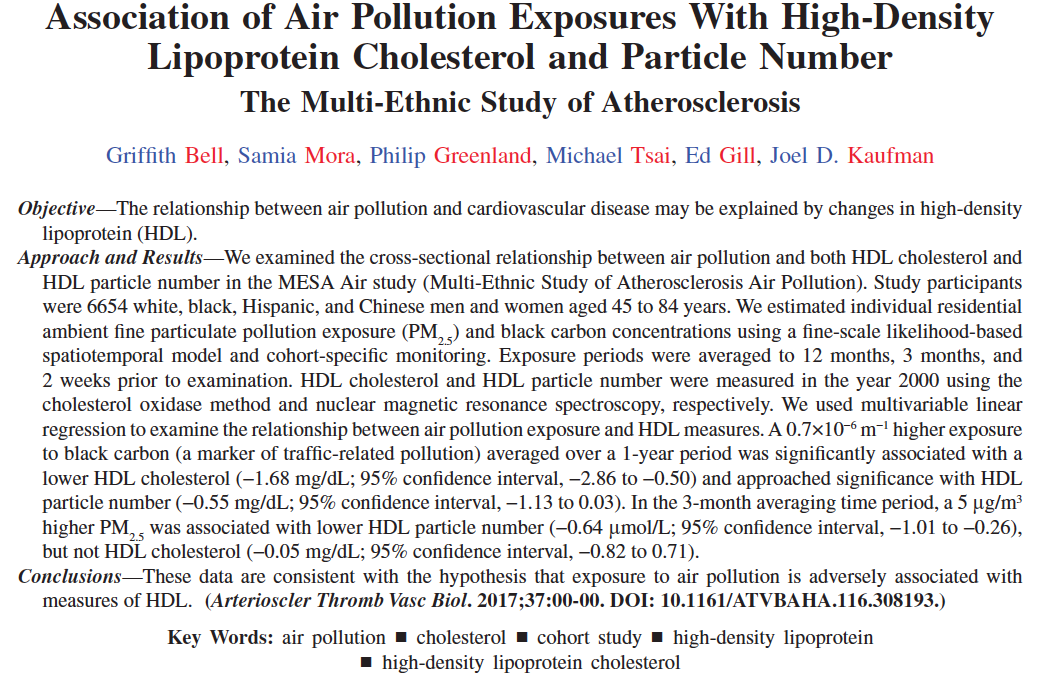I can’t believe this junk gets published.

The ‘researchers’ conclude that every 0.7 micrograms/m3 greater exposure to PM2.5 averaged over a 1-year period reduces HDL (“good”) cholesterol level by a slight amount (1.68 mg/dL).
As is usual with these sorts of studies, greater precision is claimed than is possible. Personal PM2.5 exposure were not measured and can vary greatly. In this study, the exposures are modeled, not measured. Also, blood chemistry depends on a great number of factors, none of which were considered by the researchers. The actual health significance of small transient changes in HDL are not known with anything close to certainty. The study illustrates how desperate air pollution researchers are since now they are trying to tie air pollution exposures to transient biochemical changes of uncertain meaning vs. actual adverse clinical effects. If this study were correct, smoking a cigarette would entirely eradicate HDL — which has never been observed. This study is just more EPA air pollution propaganda — not science.
Also please note that EPA human experiment cretin Joel D. Kaufman (University of Washington) is one of the study authors.

The media release and abstract are below.
###
‘Bad’ air may impact ‘good’ cholesterol increasing heart disease risk
Arteriosclerosis, Thrombosis, and Vascular Biology Journal Report
AMERICAN HEART ASSOCIATION
DALLAS, April 13, 2017 – Traffic-related air pollution may increase cardiovascular disease risk by lowering levels of high-density lipoprotein (HDL), commonly known as “good” cholesterol, according to new research in the American Heart Association’s journal Arteriosclerosis, Thrombosis, and Vascular Biology.
Scientists have long known that air pollution increases the risk of developing cardiovascular diseases including atherosclerosis and heart failure, but are uncertain how the two are connected. The connection may be explained by a reduction in the number of small, cholesterol-depleted HDL particles, leaving the average amount of cholesterol in HDL particles higher on a per-particle basis. Recent evidence suggests that the number and functionality of HDL particles may be a better gauge of HDL’s heart-healthy effects than their cholesterol content, said lead author Griffith Bell, Ph.D., M.P.H., from the University of Washington School of Public Health in Seattle.
In a study of 6,654 middle-aged and older U.S. adults from diverse ethnic backgrounds, participants living in areas with high levels of traffic-related air pollution tended to have lower HDL levels.
Researchers found:
Higher exposure to black carbon (a marker of traffic-related pollution) averaged over a one year period was significantly associated with a lower “good” cholesterol level.
Higher particulate matter exposure over three months was associated with a lower HDL particle number.
Men and women responded to air pollutants differently: HDL was lower at higher pollution exposure for both sexes, but the magnitude was greater in women.
The lower levels of HDL observed with high levels of air pollution “may put individuals at a higher risk for cardiovascular disease down the line,” Bell said.
Changes in HDL levels may already appear after brief and medium-length exposures to air pollution, the authors noted.
The findings are part of the Multi-Ethnic Study of Atherosclerosis, an ongoing U.S. study examining the lifestyle factors that predict development of cardiovascular disease. This study follows a large, diverse population and unlike many previous studies on the health effects of air pollution that assumed individuals living in the same city have the same level of air pollution exposure, this study used cohort-focused monitoring campaigns looking at time and place to estimate air pollution exposure for each study participant, Bell said. It is also the first large cohort study to examine associations between air pollution and HDL particle number, he added.
However, HDL particle numbers were measured only once in this analysis, so “we were unable to examine whether they changed over time,” Bell noted. Continuing to track how HDL levels change with extent of exposure to traffic air pollution and investigating how air pollution interferes with HDL’s activity in the body will help confirm and understand the role of HDL, Bell added. Nonetheless, “our study helps strengthen the biological plausibility of the link between traffic-related air pollution and cardiovascular disease,” he said. “We’re slowly beginning to understand some of the biology of how that link works.”
###
Co-authors are Samia Mora, M.D.; Philip Greenland, M.D.; Michael Tsai, Ph.D.; Edward A. Gill, M.D. and Joel D. Kaufman, M.D., M.P.H. Author disclosures are on the manuscript.
The National Heart, Lung, and Blood Institute, National Center for Research Resources, National Institute for Environmental Health Sciences, U.S. Environmental Protection Agency, and LipoScience, Inc. funded this study.
###

The findings showed that for young individuals, under the age of 50, having abnormally low good cholesterol may increase the risk of heart attack than those with elevated bad cholesterol.
“Some studies indicate may cause–” Disregard.
We have reached a point in time when “scientists” are clowns in bow ties (Nye) and the general population knows it.
Hey, Steve. I an believe this junk gets published. It’s where the money is. C’mon.